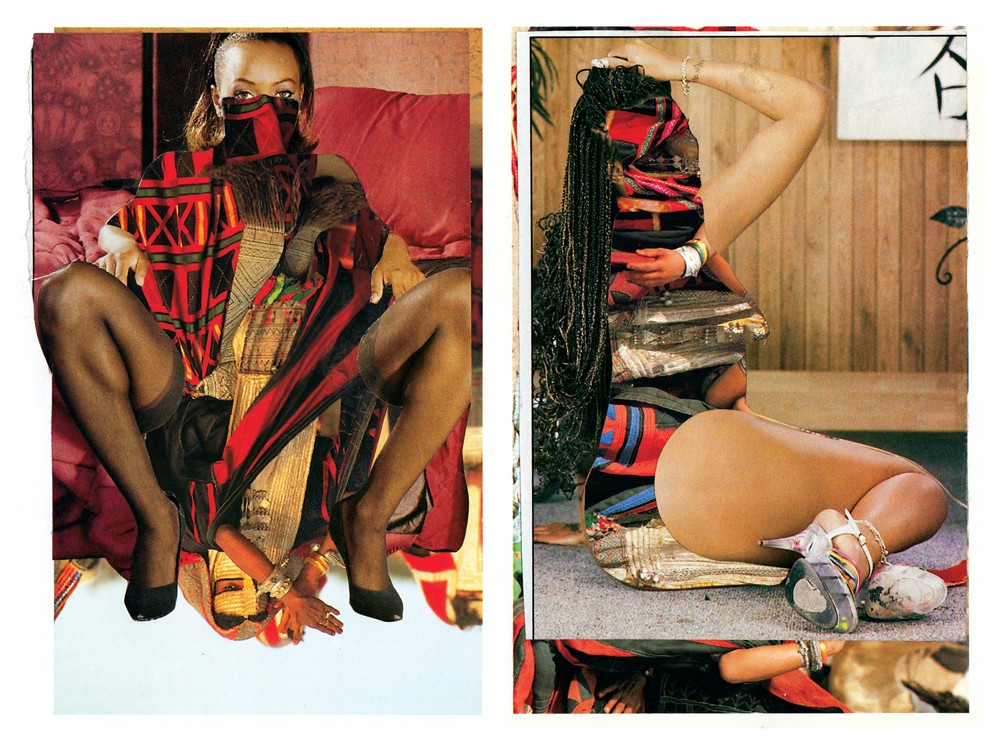Bridge 1 – Project Deconstruction
Wangechi Mutu: The Ark Collection
Wangechi Mutu is a multi-media artist, exploring issues of race and gender. She is considered to be an influential figure in contemporary art, promoting Feminism and raising awareness to African politics. Her works tend to revolve around female body image, and African-culture representations in Western cultures.
The Ark Collection is a series of collages made by Mutu. The image source of each of the collages is of a woman posing in a supposedly sexual gesture (assumable from a porn magazine). Most parts of her are not displayed, her body is emptied, and what left is the outline of a particular gesture and, at the most, one or two of her body part. The rest of the body, contains cutouts of African woman in typical African clothes and jewels, as we tend to see them on National Geographic. In first glance, it is hard to tell where one part of the collage ends and the other begins – They are all pressed together into one distinct form.
Looking into the details, the spectator can notice a woman’s face covered in a Hijab, an African-looking colourful Necklace or a dark-skinned arm adorned with golden bracelets. The porn shot on which the collage is based on, is not so much pornographic, since most of the body parts are covered with other images. Mutu unloads the pornographic woman from sexual substance, practically and metaphorically.
The artist does the same with the African images filling the body outlines. She mixes dozens of popular representations of African woman: Colourful textures and exotic jewellery are put together with no distinction (perception), personality (identity) or substance. Mutu forces the spectator to confront the superficiality and vapidity of these representations. In this extend, she criticises our distorted view of African women.
Why doesn’t she visualise these contrast and irony in a more simple form? By using only a couple of images, black on white? Perhaps because reality is not that unequivocal as it is comfortable to perceive. Representations of African culture and sexuality in visual culture are not only in mass, but also in diversity. They shift from one media to the other and between contexts, but that doesn’t make them any less shallow (schematic).
Maybe that is why Mutu uses a variety of pornographic representation: some offer more submissive, apologetic gestures, while others convey a more confident and straightforward sexuality. Also the African imagery she uses is varied in shapes and colors. Just as the message is not coherent, so is the visual outcome.
In an interview to Border Crossings Magazine, Mutu explains that she never plans how an artwork will look like. She investigates and plays with the ideas that concern her without knowing if, and how, would they work together. Would they compliment one another and integrate in harmony? Would the merging of them make any logic sense? She compares her method to putting together two unrelated music instruments — they may sound beautiful at times, and in others sound incredibly incongruous.
In The Ark Collection, such as in other of her artworks, Mutu provides visual expressions to the issues that concern her. The series express a subtle, charming and non-provocative criticism that allows the spectator to review these important matters. Some of the conceptual and visual relationships within her work seem natural, while other are more grotesque. But in all, she manages to create a very aesthetic product, slightly resembling an editorial fashion shoot. The questions that led her to make these collages in the first place, are perhaps the same questions reflected back at the spectator: this what you call civilisation? Or in other words: how do we conceptualise sexuality, Africa, woman, or all of them combined? And what does it tell us about ourselves?
Bibliography:
- Clark, Vicky A., and Sandhini Poddar. Figures of thinking: convergences in contemporary cultures. New York: Pamela Auchincloss/Arts Management, 2005.
- Mutu, Wangechi, and Josée Bélisle. Wangechi Mutu: du 2 Février au 22 Avril 2012. Montréal: Musée d’art contemporain de Montréal, 2012.
-
Moos, David. Wangechi Mutu: This You Call Civilization? Toronto: Art Gallery of Ontario, 2010.
- “Art Gallery of Ontario.” Provocative Kenyan-Born Artist Wangechi Mutu to Tear Up Gallery Walls in Canadian Debut | AGO Art Gallery of Ontario. http://www.ago.net/provocative-artist-wangechi-mutu-to-tear-up-gallery-walls-in-canadian-debut.
- “Resonant Surgeries: The Collaged World of Wangechi Mutu.” Resonant Surgeries: The Collaged World of Wangechi Mutu – Border Crossings Magazine.http://bordercrossingsmag.com/article/resonant-surgeries-the-collaged-world-of-wangechi-mutu.


